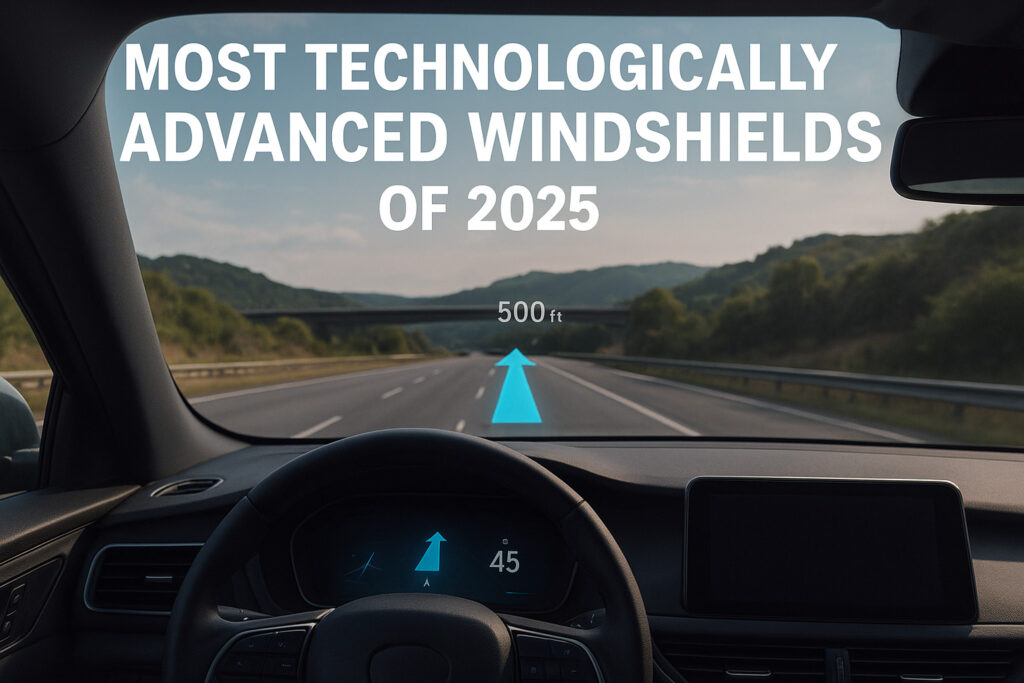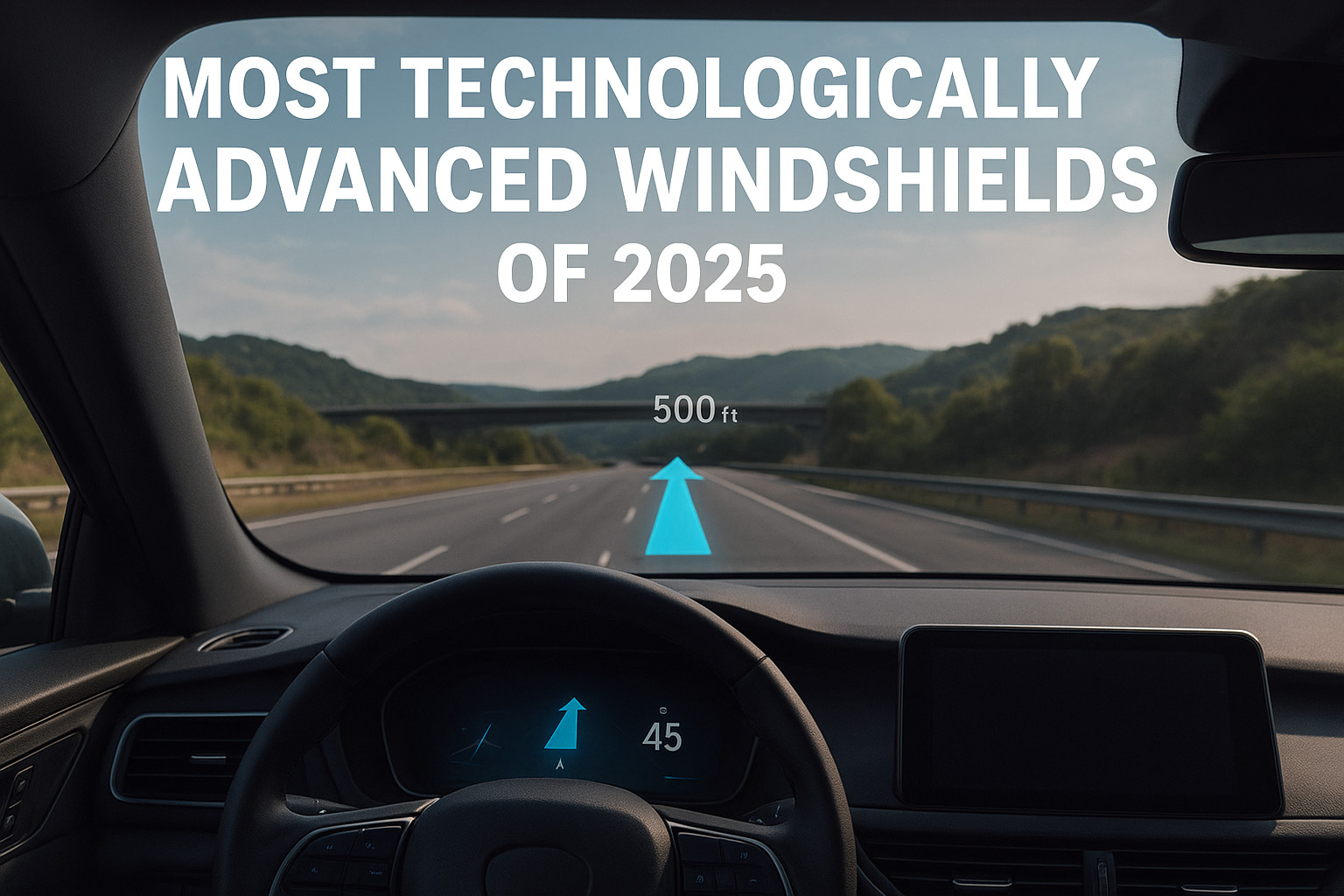The humble windshield has quietly become one of the most important high-tech components on modern cars. It’s no longer just glass: today’s windshields can host cameras and sensors that drive lane keeping and automatic braking, serve as a surface for head-up and augmented-reality displays, include heating and dimming layers, and must meet strict optical standards so driver-assist systems work reliably.
Below I explain what “advanced” windshield technology actually means, walk through the windshield tech used by major carmakers, offer a ranked list based on how integrated and advanced their windshield systems are, and explain why an undamaged, properly installed windshield matters for safety and performance. (Note: the descriptions and ranking below are based on industry developments through mid-2024; auto makers continue to add features, so specifics can change year-to-year.)
What makes a windshield “technologically advanced”?
When evaluating windshield tech I use these practical, consumer-facing criteria:
- ADAS camera/sensor integration: Is the windshield the mounting point for forward-facing cameras, driver-monitoring cameras, rain/ambient sensors or LIDAR/laser optics that must sit precisely on the glass?
- Hands-free / mapping-based driver assistance dependence: Systems like GM’s Super Cruise and Ford’s BlueCruise require precise windshield-mounted cameras or housings and mapped-data integration.
- Heads-Up Display (HUD) sophistication: Standard HUDs project speed/alerts; augmented-reality (AR) HUDs project navigational cues that appear to be “on the road.” AR HUDs typically require special laminated glass or optical combiners.
- In-glass / electrochromic or heating elements: Heated windshields, electrochromic (auto-dimming) glass, embedded antennas or sensors, acoustic laminates for noise, or solar reflective coatings.
- Calibration complexity & OEM requirements: If replacement requires factory-level recalibration, special adhesives, or programmed reinstallation, that indicates high integration.
- Safety integration: Structural bonding that works with airbag and roof-crush safety systems.
A brand that checks several of these boxes—especially AR HUDs plus advanced ADAS tied to windshield-mounted optics—earns higher marks.
Brand-by-brand: what to expect from the windshield
Below I cover common windshield technologies from leading brands and what makes each one notable.
1. Mercedes-Benz
What they do: Mercedes has been an early adopter of AR-style HUDs and advanced windshield-integrated systems. Mercedes’ MBUX system includes augmented navigation overlays in available head-up displays and tight ADAS integration (Active Distance Assist, Active Lane Change Assist). Many Mercedes models use a windshield area that includes camera housings and driver-monitoring sensors that must be precisely aligned.
Why it matters: AR HUD + integrated ADAS creates a premium windshield that requires OEM-level calibration when replaced.
2. Tesla
What they do: Tesla’s Autopilot/FSD systems rely heavily on multiple external cameras — several of which are mounted behind or adjacent to the windshield — and the company designs glass packages that balance wide visibility and optics for those cameras. Tesla glass also often has thermal/solar treatments and acoustic laminates on higher trims.
Why it matters: Tesla’s software relies on clear, correctly positioned camera views; windshield damage or incorrect installation can interfere with Autopilot camera inputs.
3. BMW
What they do: BMW offers AR HUDs on higher-end models (where navigation cues and lane information are projected with apparent depth), and its ADAS systems use windshield-mounted camera modules. BMW also focuses on low-distortion laminates and acoustic glass on luxury models.
Why it matters: BMW’s HUD + camera combination requires the right glass geometry and precise recalibration after service.
4. General Motors (Cadillac, Chevrolet, GMC)
What they do: GM’s Super Cruise (Cadillac) and expanding hands-free OnStar features use a combination of high-precision maps, a windshield-mounted driver-facing camera for attention monitoring, and forward-facing camera housings. That means the windshield and its mounting must be factory-accurate.
Why it matters: Super Cruise is an example where windshield alignment and calibration are mission-critical to the hands-free function.
5. Ford
What they do: Ford’s BlueCruise and Co-Pilot features integrate windshield-mounted cameras and HUDs (called Active Driving Display on many vehicles). Higher trims may include upgraded laminated glass and heated windshields.
Why it matters: Like GM, Ford’s hands-free driving tech makes proper windshield installation and calibration essential.
6. Subaru
What they do: Subaru’s EyeSight system uses stereo forward-facing cameras that are housed on the windshield faring. EyeSight is unique in that it uses two cameras to create depth perception—this makes windshield quality and precise alignment extremely important.
Why it matters: Even small chips or optical imperfections in front of EyeSight’s cameras can degrade system performance. Subaru owners must be careful to get exact OEM-spec replacements and calibration.
7. Audi
What they do: Audi offers advanced HUDs on many models and has explored AR HUD elements; Audi’s ADAS cameras and sensors are typically windshield-mounted or near the rearview. Their high-end glass often includes acoustic laminates and special coatings.
Why it matters: Audi’s AR ambitions and emphasis on refined optics push windshield complexity higher on premium models.
8. Volvo
What they do: Volvo is safety-centric: windshields often host camera-based ADAS modules, and Volvo equips many models with laminated, acoustic glass and smart sensors for automatic wipers and collision systems.
Why it matters: Volvo’s systems are tuned to rely on high optical standards and manufacturer-specified service.
9. Hyundai / Genesis / Kia
What they do: The Hyundai group has rapidly added AR HUDs and advanced ADAS to Genesis and higher Hyundai/Kia models. Windshields on flagship models may be laminated with improved optical quality and include HUD combiners.
Why it matters: Rapid tech adoption across mainstream and premium models means many owners will encounter windshields that require careful OEM-spec replacement.
10. Toyota / Lexus
What they do: Toyota Safety Sense and Lexus safety suites use windshield-mounted forward cameras and sensors across many models. Lexus in particular adds refined HUDs on luxury models and often pairs camera ADAS with driver-monitoring and HUD overlays.
Why it matters: Reliable ADAS means windshield optics and alignment are important for consistent operation.
Note: other manufacturers (Jaguar Land Rover, Porsche, Lucid, Rivian, etc.) are also pushing windshield tech—Lucid and some EV startups focus on large panoramic glass with acoustic and optical engineering, and luxury marques experiment with AR HUDs—so the field is expanding quickly.
Why your windshield matters
People often assume windshield damage is only cosmetic or structural. For modern cars the windshield is part of the sensor ecosystem — and damage can undermine that ecosystem in several ways:
- Optical distortion for cameras: Chips, cracks, or poor repairs can refract or block the camera’s view. That leads to reduced lane-keeping accuracy, missed automatic braking events, false warnings, or system disablement.
- Misalignment risk: If the windshield is not seated or bonded to OEM tolerances, forward-facing cameras and HUD projectors will be out of calibration.
- HUD / AR degradation: Dirt, delamination, or chips near the HUD combiner area reduce the clarity and contrast of projections, making navigation cues harder to see.
- Structural & airbag performance: The windshield is often a bonded part of the vehicle’s structure and can affect roof crush resistance and airbag deployment geometry.
- Driver monitoring impairment: Cameras that monitor for driver attention need a clear, unobstructed line of sight.
In short: a cracked or improperly replaced windshield can cause ADAS features to behave incorrectly, reduce your safety margin, and produce distracting or unreliable displays.
Replacing a windshield when ADAS/HUD is involved — practical checklist
If your vehicle has any ADAS, HUD, or windshield-mounted cameras, follow these steps when you need a replacement:
- Check the owner’s manual and manufacturer guidance — many automakers explicitly require recalibration after windshield replacement.
- Choose a shop experienced with ADAS calibration — ask whether they perform OEM-specified static or dynamic calibrations and whether they have the tools and manufacturer software.
- Confirm glass and adhesives meet OEM specs — some systems require particular glass laminates or optical tolerances and specific urethane adhesives.
- Ask about camera housings & sensor reinstallation — sensors are often removed and reinstalled; they must be re-aligned to factory tolerances.
- Get documentation — request a written record of the calibration procedure and test results.
- Perform a system check / test drive — after replacement and calibration the shop should verify lane keeping, AEB, adaptive cruise, HUD alignment, and camera warnings are functioning as designed.
- Don’t delay repairs — chips can grow, and any delay increases cost and risk.
How to find a trusted shop — use our free quote tool
Because modern windshields often require specific glass, adhesives, and calibration equipment, it’s worth comparing certified shops.
Use glass.net’s free quote tool to compare trusted local shops and ask them directly about:
- OEM-spec glass availability
- ADAS/HUD recalibration experience and tools
- Warranty on workmanship and glass
- Whether they provide written calibration/test documentation
Getting multiple quotes helps you find a shop that both understands windshield tech and follows OEM procedures.

To read more, visit blog.glass.net

